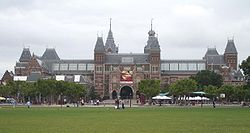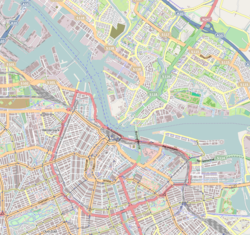Rijksmuseum
You can help expand this article with text translated from the corresponding article in Dutch. (July 2011) Click [show] for important translation instructions.
|
 Rijksmuseum as seen from the Museumplein | |
| Established | 1800 |
|---|---|
| Location | Museumplein Amsterdam, Netherlands |
| Type | National museum |
| Visitors | 880,000 (2009)[1]
|
| Director | Wim Pijbes[3] |
| Curator | Taco Dibbits[3] |
| Public transit access | Trams 2, 5, 6, 7, 10, 12[4] |
| Website | www.rijksmuseum.nl |
The Rijksmuseum Amsterdam or simply Rijksmuseum (Dutch pronunciation: [rɛi̯ks myˈzeʏm]) (English: State Museum) is a Dutch national museum in Amsterdam, located on the Museumplein. The museum is dedicated to arts, crafts, and history. It has a large collection of paintings from the Dutch Golden Age and a substantial collection of Asian art. It also displays the stern of the HMS Royal Charles which was captured in the Raid on the Medway, and the Hartog plate.
Foundation
The museum was founded in 1800 in The Hague to exhibit the collections of the Dutch stadtholders. It was inspired by French example. By then it was known as the National Art Gallery (Dutch: Nationale Kunst-Gallerij). In 1808 the museum moved to Amsterdam on the orders of king Louis Bonaparte, brother of Napoleon Bonaparte. The paintings owned by that city, such as The Night Watch by Rembrandt, became part of the collection.
Cuypers' building

In 1863, there was a design contest for a new building for the Rijksmuseum, but none of the submissions was considered to be of sufficient quality. Pierre Cuypers also participated in the contest and his submission reached the second place. In 1876 a new contest was held and this time Pierre Cuypers won. The design was a combination of gothic and renaissance elements. The construction began on October 1, 1876. On both the inside and the outside, the building was richly decorated with references to Dutch art history. Another contest was held for these decorations. The winners were B. van Hove and J.F. Vermeylen for the sculptures, G. Sturm for the tile tableaus and painting and W.F. Dixon for the stained glass. The museum was opened at its new location on July 13, 1885.[5]
The front of the museum is located at the Stadhouderskade, but on the other side it has a prominent position on the Museumplein, nowadays among the Van Gogh Museum, the Stedelijk Museum Amsterdam, and the Concertgebouw.

In 1890 a fragment building was added to the Rijksmuseum. This building was made out of fragments of demolished buildings that together give an overview of the Dutch history of architecture. In 1906 the hall for the Night Watch was rebuilt.[5] In the interior more changes were made, between the 1920s and 1950s most multi-coloured wall decorations were painted over. In the 1960s exposition rooms and several floors were built into the two courtyards. The building had some minor renovations and restorations in 1984, 1995–1996 and 2000.[6] From 2003 until 2013[7] the Rijksmuseum will be restored and renovated based on a design by Spanish architects Antonio Cruz and Antonio Ortiz. Many of the old interior decorations will be restored and the floors in the courtyards will be removed. During the restoration and renovation process only about four hundred of the one-million piece permanent collection are on display in an exhibition called The Masterpieces in the already renovated "fragment building," nowadays called the Philips wing.[8]
Library
The Rijksmuseum Research Library is part of the Rijksmuseum, and is the largest public art history research library in The Netherlands.
Collection
The paintings collection includes works by artists Jacob van Ruysdael, Frans Hals, Johannes Vermeer, Jan Steen and Rembrandt and Rembrandt's pupils.
Rembrandt

The Paintings in the collection by Rembrandt van Rijn:
- Tobit and Anna with the Kid
- Musical Allegory
- Self Portrait 1629
- Jeremiah Lamenting the Destruction of Jerusalem
- An Old Woman Reading, probably the Prophetess Anna
- Bust of Young Woman (probably Saskia van Uylenburgh)
- Joseph Telling his Dreams
- Portrait of Johannes Wtenbogaert
- Portrait of van Haesje Jacobsdr van Cleyburgh
- Landscape with a Stone Bridge
- Dead Peacocks and a Girl
- Portrait of Maria Trip
- The Company of Captain Frans Banning Cocq and Lieutenant Willem van Ruytenburch
- Portrait of Ephraim Bueno
- The Denial of Peter
- Titus as a Monk
- Self-portrait as the Apostle Paul
- Syndics of the Drapers' Guild
- The Jewish Bride
Johannes Vermeer

Paintings in the collection by Johannes Vermeer:
Frans Hals

Paintings in the collection by Frans Hals:
- Portrait of a Young Couple
- The Company of Reynier Real
- The Jolly Drinker
- Portrait of Lucas De Clercq
- Portrait of Nicolaes Hasselaer
- Portrait of a Man
Jan Steen
Paintings in the collection by Jan Steen.
- The Feast of Saint Nicholas
- The Drunken Pair
- The Toilet
- Adolf en Catharina Croeser
- Arent Oostwaard and his wife
References
- ^ Template:Nl icon Rijksmuseum in 2009 succesvol in buitenland. Rijksmuseum Amsterdam. Retrieved on 2010-12-23.
- ^ Template:Nl icon Musea hebben lak aan recessie. DagjeWeg.nl. Retrieved on 2010-12-23.
- ^ a b Organisation. Rijksmuseum Amsterdam. Retrieved on 2010-12-23.
- ^ Directions to the Rijksmuseum. Rijksmuseum Amsterdam. Retrieved on 2010-12-23.
- ^ a b "Stadhouderskade 42. Rijksmuseum (1876/85)". Monumenten en Archeologie in Amsterdam. City of Amsterdam. Archived from the original on 2007-02-09. Retrieved 2007-04-01.
{{cite web}}: External link in|work= - ^ "Stadhouderskade 42. Rijksmuseum (1876/85). Interieur". Monumenten en Archeologie in Amsterdam. City of Amsterdam. Archived from the original on 2007-02-02. Retrieved 2007-04-01.
{{cite web}}: External link in|work= - ^ "Rijksmuseum reopening delayed until 2013". DutchNews.nl. 2008-02-27. Retrieved 2008-12-08.
- ^ "Final Design The New Rijksmuseum". The New Rijksmuseum. Rijksmuseum Amsterdam. Retrieved 2007-04-01.
{{cite web}}: External link in|work=
External links
- Rijksmuseum Amsterdam – in six languages
- Paintings at the Rijksmuseum (in English)

